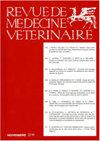Riesgos a la salud por el uso de clorhidrato de clembuterol: una revisión
Q2 Veterinary
引用次数: 4
Abstract
This paper analyzes and evaluates information about the characteristics and risks of using Clenbuterol hydrochloride (CCL) for their potential toxic effects, due to its inclusion in animal food (cattle, pigs, sheep and poultry) to improve productive-reproductive parameters, but neglecting food safety. Therefore, it is necessary to reassess the potential dangers that may result when used in both human and veterinary medicine. The β-adrenergic synthetic CCL, white powder, anhydrous, highly water soluble and highly stable at room temperature is used in a clandestine manner to fatten animals for human consumption. Therapeutically, it is used as a bronchodilator drug (asthma patients); its illegal use (doping) has been detected in sports competitions, and it is used for bodybuilding due to its anabolic effect. Its use in cattle for slaughter modifies and increases the growth of muscle mass and reduces fat accumulation, which accumulates in different organs. In people with a history of bovine liver consumption contaminated with CCL, there has been registration of: tremor, muscle pain, dizziness, headache, and tachycardia. In Mexico, in an illegal and clandestine manner, there is distribution, marketing and use of CCL; however, the work of livestock organizations in registering production units free of this substance will ensure the consumption of meat products. Moreover, to propose the use of other substances which so far have no signs of toxicity will lead to a sustainable, secure and safe productivity in livestock units.使用盐酸克伦特罗的健康风险:综述
本文分析和评价盐酸克仑特罗(盐酸克仑特罗,CCL)的特点和潜在毒性影响,因为它被添加到动物食品(牛、猪、羊和家禽)中以提高生产-繁殖参数,但忽视了食品安全。因此,有必要重新评估在人类和兽药中使用时可能产生的潜在危险。β-肾上腺素能合成CCL,白色粉末,无水,高水溶性,室温下高度稳定,用于秘密喂养动物供人类食用。在治疗上,它被用作支气管扩张药物(哮喘患者);它的非法使用(兴奋剂)已经在体育比赛中被发现,由于它的合成代谢作用,它被用于健身。它在牛的屠宰中使用,可以改变和增加肌肉质量的增长,减少脂肪的积累,脂肪积聚在不同的器官中。在食用受CCL污染的牛肝史的人群中,有以下记录:震颤、肌肉疼痛、头晕、头痛和心动过速。在墨西哥,以非法和秘密的方式分销、销售和使用CCL;然而,畜牧组织在登记不含这种物质的生产单位方面的工作将确保肉类产品的消费。此外,建议使用迄今为止没有毒性迹象的其他物质将导致牲畜单位的可持续、安全和安全生产力。
本文章由计算机程序翻译,如有差异,请以英文原文为准。
求助全文
约1分钟内获得全文
求助全文
来源期刊

Revue De Medecine Veterinaire
农林科学-兽医学
CiteScore
1.30
自引率
0.00%
发文量
0
审稿时长
18-36 weeks
期刊介绍:
The Revue de Médecine Vétérinaire publishes four kinds of text:
1) Scientific reviews on subjects related to veterinary and comparative medicine. Suggested length: 10 to 30 typed pages.
2) Original reports on fundamental or applied research. Suggested length: 10 to 15 typed pages.
3) Continuous education articles, that should be easily understandable by non-specialists. Suggested length: 10 to 15 typed pages.
4) Clinical reports. Suggested length: 5 to 15 typed pages.
The publication can be done in French language or English language.
For an article written in English by not english native speakers authors, the manuscript must be subjected by attesting that it was read again by an anglophone scientist or a scientific translator.
The authors must certify that the manuscript was not published or subjected for publication to another review.
The manuscript must be accompanied by a sheet signed by all the joint authors indicating their agreement for the tender of the manuscript.
The publication is free but a financial participation could be required for the photographs color. An estimate will be sent to collect the agreement of the authors.
 求助内容:
求助内容: 应助结果提醒方式:
应助结果提醒方式:


